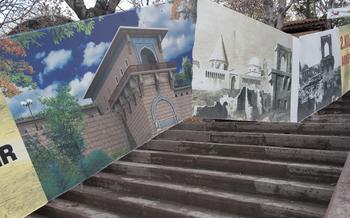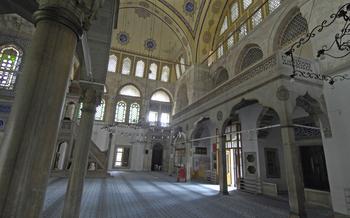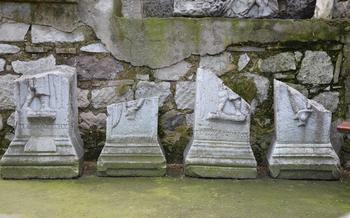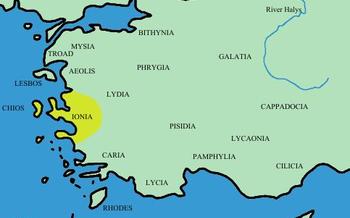
Mevlana Mosque and Complex
- Mevlana Mosque and Complex: An Ode to Sufism and Rumi's Legacy
- The Sama Ceremony: A Whirling Dervish Experience
- Origins and Significance
- The Whirling Dervishes
- The Music and Poetry
- Attending a Sema Ceremony
- Mevlana Museum: Unveiling Rumi's Life and Teachings
- Green Tomb: A Majestic Mausoleum in Manisa
- Manisa Castle: A Historic Citadel with Panoramic Views
- Manisa Ulu Mosque: A Symbol of Seljuk Architecture
- Manisa Archeological Museum: A Journey Through History
- Spil Mountain National Park: A Natural Haven
- Sardis: An Ancient City with a Rich Past
- The Village of Şirince: A Charming Getaway
- Kula Historical Bazaar: A Vibrant Marketplace
- Manisa Thermal Springs: A Relaxing Retreat
- Tmolus Mountain: A Hiking and Nature Adventure
- Insider Tip: Experience the Mevlana Whirling Dervishes Ceremony
Mevlana Mosque and Complex: An Ode to Sufism and Rumi's Legacy
Historical significance:
The Mevlana Mosque and Complex in Konya, Turkey, holds immense historical significance as the final resting place of the renowned 13th-century Persian poet, mystic, and Islamic scholar, Jalal ad-Din Muhammad Rumi. Rumi, also known as Mevlana, founded the Mevlevi Order, a Sufi order that emphasized the importance of love, tolerance, and spiritual enlightenment. The Mevlana Mosque and Complex serves as a testament to Rumi's profound impact on Sufi Islam and his enduring legacy as one of the most influential spiritual figures in history.
Architectural marvels:
The Mevlana Mosque and Complex is an architectural masterpiece that seamlessly blends Seljuk and Ottoman architectural styles. The mosque's striking features include its magnificent dome, intricate tilework, and graceful minarets. The complex also encompasses Rumi's mausoleum, a theological school, a library, and a dervish lodge, all of which are adorned with exquisite craftsmanship and symbolism that reflect the Mevlevi Order's unique spiritual practices.
Rumi's Mausoleum:
At the heart of the complex lies Rumi's mausoleum, a sacred space that attracts pilgrims and visitors from around the world. The mausoleum is adorned with intricate tilework, calligraphy, and a magnificent cenotaph that marks Rumi's final resting place. Visitors can pay homage to Rumi and other prominent Sufi figures buried within the mausoleum, seeking spiritual guidance and inspiration from their teachings.
Sema Ceremony:
One of the most captivating highlights of the Mevlana Mosque and Complex is the Sema Ceremony, a mesmerizing ritual performed by the Mevlevi dervishes. This UNESCO-recognized ceremony involves the dervishes whirling in a synchronized and graceful manner, representing their spiritual journey towards divine love and enlightenment. The Sema Ceremony is a powerful and moving experience that offers a glimpse into the mystical traditions of Sufism.
The Sama Ceremony: A Whirling Dervish Experience
The Sema ceremony, also known as the Whirling Dervishes ceremony, is a mesmerizing spectacle that showcases the spiritual and cultural heritage of Sufism. This sacred ritual, recognized by UNESCO as a Masterpiece of the Oral and Intangible Heritage of Humanity, offers a profound insight into the mystical teachings of Rumi.
Origins and Significance
The Sema ceremony originated in the 13th century as a form of devotion and remembrance of Rumi, the founder of the Mevlana Order. Dervishes, or Sufi practitioners, perform the ceremony to connect with the divine and express their love for God through movement and music. The ceremony symbolizes the journey of the soul towards spiritual perfection, representing the individual's quest for enlightenment and union with the divine.
The Whirling Dervishes
The Whirling Dervishes are highly trained and devoted individuals who undergo rigorous training to master the art of sema. They wear long, flowing white robes that represent purity and surrender. The whirling motion, performed with arms outstretched, signifies the dervishes' detachment from worldly desires and their connection to the divine. Each movement is carefully choreographed and synchronized, creating a mesmerizing and meditative atmosphere.
The Music and Poetry
The Sema ceremony is accompanied by enchanting music and poetry, which play a crucial role in creating the spiritual ambiance. The music is composed of traditional Sufi melodies, often played on instruments such as the ney (reed flute) and the kudüm (goblet drum). The poetry, recited in Turkish, Arabic, or Persian, consists of Rumi's verses and hymns that express profound spiritual truths and guide the dervishes through their journey.
Attending a Sema Ceremony
To attend a Sema ceremony, it is essential to dress modestly and respectfully. Visitors are expected to maintain silence and refrain from taking photos or videos during the performance. The ceremony typically lasts for around an hour and concludes with a prayer. After the ceremony, visitors can explore the Mevlana Museum to learn more about Rumi's life and teachings.
Mevlana Museum: Unveiling Rumi's Life and Teachings
The Mevlana Museum, housed within the Mevlana Complex, offers a profound insight into the life and teachings of the renowned Sufi mystic, Rumi. This captivating museum showcases a diverse collection of artifacts, manuscripts, and interactive exhibits that illuminate Rumi's journey and his enduring legacy. Among the highlights are Rumi's personal belongings, such as his clothing, prayer rug, and writing implements, which provide a tangible connection to his daily life.
Interactive displays bring Rumi's teachings to life, allowing visitors to engage with his profound insights on love, spirituality, and the nature of existence. Delve into the intricacies of Rumi's magnum opus, the Masnavi, a collection of spiritual poems that has captivated readers for centuries. Through these exhibits, the museum invites visitors to explore the depths of Rumi's wisdom and understand its profound impact on literature, art, and spirituality across the globe.
Green Tomb: A Majestic Mausoleum in Manisa
Manisa's Green Tomb stands as a testament to the region's rich architectural heritage. Constructed in the 14th century, this magnificent mausoleum is renowned for its stunning tilework and intricate decorations. The tomb's striking green exterior, a result of the unique glazed tiles used in its construction, has earned it the title of "Green Tomb."
Admire the intricate tilework that adorns the tomb's facade, depicting scenes from the Quran and stories from Islamic history. The interior is equally impressive, with its delicate calligraphy and vibrant colors creating a sense of awe and wonder. Discover the symbolism and stories behind the intricate tilework and calligraphy, which hold profound spiritual and cultural significance.
Uncover the legend associated with the tomb's unique green color. According to local folklore, the tomb was originally white, but it turned green overnight due to the intervention of a saint. This legend adds a touch of mysticism and wonder to the already captivating story of the Green Tomb.
Manisa Castle: A Historic Citadel with Panoramic Views
Manisa Castle, a majestic symbol of the city's rich history, stands as a testament to the region's strategic importance throughout the ages. Explore the castle's imposing fortifications, marvel at the breathtaking panoramic views from its ramparts, and delve into the captivating legends associated with this iconic landmark.
Fortified Walls: Stroll along the castle's imposing fortified walls, constructed with precision and strength to withstand countless sieges. Admire the towering ramparts, sturdy towers, and intricate gateways that once protected the city from invaders.
Panoramic Vistas: Ascend to the castle's ramparts and be rewarded with breathtaking panoramic vistas of Manisa and its surroundings. Gaze upon the sprawling cityscape, the fertile plains, and the distant mountains that embrace this historic city.
Museum Exhibits: Step into the castle's museum to embark on a journey through time. Discover fascinating exhibits that shed light on the castle's history, its role in Manisa's defense, and the lives of its former inhabitants.
The Castle's Legends: Unravel the captivating legends that surround Manisa Castle. Hear tales of heroic battles, hidden treasures, and ghostly apparitions that add an air of mystery to this historic site.
Manisa Ulu Mosque: A Symbol of Seljuk Architecture
The Manisa Ulu Mosque, also known as the Great Mosque of Manisa, stands as a testament to the Seljuk dynasty's architectural prowess. Constructed in the 14th century, the mosque boasts a distinctive Seljuk architectural style, characterized by its grand dome and elegant minarets.
Explore the mosque's interior to discover intricate tilework, calligraphy, and a magnificent mihrab that adorns the qibla wall. Marvel at the harmonious blend of Islamic art and architecture, which creates a serene and awe-inspiring atmosphere.
The Manisa Ulu Mosque holds significant historical importance as a religious and cultural center during the Seljuk period. It served as a place of worship, learning, and community gatherings, playing a vital role in shaping the city's Islamic heritage.
To this day, the Manisa Ulu Mosque remains a symbol of Manisa's rich cultural and architectural legacy. It continues to attract visitors and worshippers alike, who come to admire its beauty, learn about its history, and experience the spiritual essence that permeates its walls.
Manisa Archeological Museum: A Journey Through History
Nestled in the heart of Manisa, the Manisa Archeological Museum is a treasure trove of artifacts that unveils the rich history and cultural heritage of the region. Embark on a journey through time as you explore the museum's diverse collection, spanning from the Bronze Age to the Roman Empire and beyond.
Ancient Artifacts:
Immerse yourself in the captivating world of ancient civilizations as you peruse the museum's collection of artifacts from various historical periods. Discover intricate pottery, bronze sculptures, and jewelry that offer glimpses into the daily lives and artistic expressions of our ancestors.
Manisa's Past:
Gain profound insights into the evolution of Manisa and its surrounding regions through the archaeological treasures housed within the museum. Learn about the city's role as a significant trading hub and cultural center throughout history.
Interactive Displays:
Engage with interactive exhibits that bring the region's past to life. Touchscreens, multimedia presentations, and hands-on activities provide an immersive and educational experience for visitors of all ages.
The Museum's Highlights:
Don't miss the museum's most notable artifacts, including the iconic "Smiling Head of Manisa." This enigmatic marble sculpture, dating back to the Roman period, captivates visitors with its serene expression and mysterious origins.
Spil Mountain National Park: A Natural Haven
Nestled amidst the picturesque landscapes of Manisa, Spil Mountain National Park beckons nature enthusiasts with its verdant forests, cascading waterfalls, and panoramic vistas. The park offers a sanctuary for diverse flora and fauna, providing opportunities for exploration, adventure, and relaxation.
Hiking Trails:
Embark on a journey through the park's enchanting trails, winding through lush forests and offering breathtaking views of the surrounding landscape. Whether you're a seasoned hiker or a casual nature lover, there's a trail to suit your preferences and fitness level.
Diverse Flora and Fauna:
Spil Mountain National Park is a haven for a rich diversity of plant and animal life. Discover rare and endangered species as you explore the park's various ecosystems, from dense forests to cascading waterfalls. Keep an eye out for colorful butterflies, soaring birds of prey, and other fascinating creatures that call the park home.
Park Facilities:
Whether you're planning a day trip or an extended stay, Spil Mountain National Park offers a range of facilities to enhance your experience. Take advantage of the well-maintained picnic areas, where you can enjoy a leisurely meal surrounded by nature. For those seeking a more immersive experience, camping grounds are available, allowing you to camp under the stars and wake up to the sound of birdsong.
A Natural Retreat:
Immerse yourself in the tranquility of Spil Mountain National Park, where you can escape the hustle and bustle of city life and reconnect with nature. Let the soothing sounds of cascading waterfalls and the gentle rustle of leaves calm your mind and rejuvenate your senses.
Sardis: An Ancient City with a Rich Past
Journey back in time to the ancient city of Sardis, once the capital of the powerful kingdom of Lydia. Unearth the city's rich history through archaeological excavations and discover artifacts that tell tales of a glorious past. Explore the ruins of the Temple of Artemis, one of the Seven Wonders of the Ancient World, and marvel at its architectural grandeur. Delve deeper into Sardis' history at the Sardis Museum, home to a treasure-trove of artifacts that bring the city's past to life. Immerse yourself in the captivating stories of Sardis, a city that once stood as a beacon of power and prosperity.
The Village of Şirince: A Charming Getaway
Nestled amidst the picturesque landscapes of Manisa, the village of Şirince beckons travelers with its captivating charm and rich historical heritage. Step into this enchanting village, and you'll be greeted by a tapestry of well-preserved traditional Ottoman-Greek architecture, showcasing the harmonious blend of cultures that have shaped its identity.
Şirince is renowned for its delectable local delicacies, particularly its wines and fruit preserves. Indulge in the village's signature wines, crafted from local grapes and boasting unique flavors that reflect the region's terroir. Don't miss the opportunity to sample the village's homemade fruit preserves, made with fresh, seasonal fruits and capturing the essence of nature's bounty.
Beyond its culinary delights, Şirince is also home to several historical sites that offer a glimpse into its storied past. The Church of Saint John the Baptist stands as a testament to the village's Christian heritage, with its intricate architecture and serene atmosphere inviting contemplation and reflection.
As you wander through the cobblestone streets of Şirince, immerse yourself in the village's tranquil atmosphere and embrace the warmth of its friendly local culture. Engage in conversations with the villagers, who are always eager to share stories and insights about their beloved village. Whether you're seeking a peaceful retreat or an exploration of rich cultural heritage, Şirince promises an unforgettable experience.
Kula Historical Bazaar: A Vibrant Marketplace
Manisa's Kula Historical Bazaar is a bustling hub of activity and a shopper's paradise. Step into this vibrant marketplace and immerse yourself in the sights, sounds, and aromas of traditional Turkish commerce. Browse the colorful stalls brimming with an array of local crafts, textiles, and fresh produce. From intricately woven carpets and handmade pottery to aromatic spices and delectable sweets, the bazaar offers a treasure trove of unique items.
Engage with the friendly vendors, who are always eager to share stories about their products and negotiate prices with a smile. Experience the lively atmosphere as locals and tourists alike haggle and barter, creating a symphony of voices that fills the air. The bazaar is not just a place to shop; it's a cultural melting pot where you can witness the vibrant spirit of Manisa's people.
As you wander through the narrow cobblestone streets, soak in the historical significance of this ancient trading center. Kula Historical Bazaar has been a vital part of Manisa's economy for centuries, and its rich history is palpable in every corner. Embrace the lively atmosphere and immerse yourself in the authentic experience of a traditional Turkish bazaar.
Manisa Thermal Springs: A Relaxing Retreat
Nestled amidst the picturesque landscapes of Manisa, the natural thermal springs offer a sanctuary for relaxation and rejuvenation. These springs have been renowned for their therapeutic properties since ancient times, attracting visitors seeking relief from various ailments. Immerse yourself in the warm, mineral-rich waters of the thermal pools, allowing your body and mind to unwind. Indulge in spa treatments and massages, designed to enhance your well-being and revitalize your senses. Discover the skin-rejuvenating and health-boosting benefits associated with thermal spring bathing. Whether you seek a soothing retreat or a complete wellness experience, Manisa's thermal springs offer a haven of relaxation and tranquility.
Tmolus Mountain: A Hiking and Nature Adventure
Tmolus Mountain, also known as Bozdağ, is a captivating natural wonder that beckons hikers and nature enthusiasts with its picturesque landscapes, diverse flora and fauna, and challenging trails. As you embark on a hiking adventure through the mountain's enchanting forests, meadows, and rocky peaks, you'll be rewarded with breathtaking panoramic views that will leave you in awe.
The trails on Tmolus Mountain cater to hikers of all levels, from leisurely strolls through lush forests to strenuous climbs to the mountain's summit. Along the way, keep your eyes peeled for the diverse array of plant and animal species that call this mountain home. Wildflowers in vibrant hues paint the landscape, while birds and butterflies flit among the trees, creating a symphony of color and sound.
Nestled amidst the slopes of Tmolus Mountain, you'll find traditional mountain villages that offer a glimpse into the region's rich cultural heritage. These villages, with their stone houses and friendly locals, provide a welcome respite from the rigors of the hike and an opportunity to experience authentic Turkish hospitality.
Whether you're seeking a challenging hike or a peaceful nature retreat, Tmolus Mountain has something to offer everyone. So lace up your hiking boots, breathe in the fresh mountain air, and prepare to be captivated by the natural beauty that awaits you.
Insider Tip: Experience the Mevlana Whirling Dervishes Ceremony
To fully immerse yourself in the spiritual and cultural significance of the Sema ceremony, it's essential to plan your visit carefully. Advance booking of tickets is highly recommended, especially during the peak tourist season, to avoid disappointment. When attending the ceremony, dress modestly and respectfully, ensuring your shoulders and knees are covered. During the performance, maintain silence and refrain from taking photos or videos as a sign of respect for the sacred nature of the ritual. After the ceremony, enhance your experience by savoring the flavors of Manisa's local cuisine at a traditional restaurant, allowing you to delve deeper into the city's rich culinary heritage.









